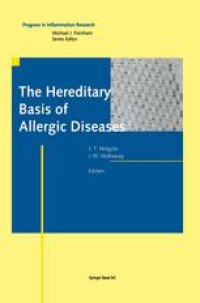
Ebook: The Hereditary Basis of Allergic Diseases
- Tags: Pharmacy
- Series: Progress in Inflammation Research
- Year: 2002
- Publisher: Birkhäuser Basel
- Edition: 1
- Language: English
- pdf
Allergic diseases are complex and involve a range of environmental factors interacting with a susceptible genotype. The familial clustering of diseases, such as asthma and hay fever, has been recognised for over two centuries, but identification of the genetic basis to this had to await the molecular biological revolution. Estimates of the contribution that genetic factors make to asthma susceptibility range from 35% to 70%. For the majority of allergic diseases, segregation analysis has not identified a consistent Mendelian pattern of inheritance, which, when combined with multiple phenotypes and environmental interactions, has made identifying candidate genes especially difficult and, at times, controversial. Part of the difficulty has been lack of agreement over phenotype definitions, reduced power of studies to predict linkage and association, and, importantly, lack of true heterogeneity between populations. Despite these difficulties, the last decade has witnessed enormous progress in this field.
Allergic diseases are complex and involve a range of environmental factors interacting with a susceptible genotype. The familial clustering of diseases, such as asthma and hay fever, has been recognised for over two centuries, but identification of the genetic basis to this had to await the molecular biological revolution. Estimates of the contribution that genetic factors make to asthma susceptibility range from 35% to 70%. For the majority of allergic diseases, segregation analysis has not identified a consistent Mendelian pattern of inheritance, which, when combined with multiple phenotypes and environmental interactions, has made identifying candidate genes especially difficult and, at times, controversial. Part of the difficulty has been lack of agreement over phenotype definitions, reduced power of studies to predict linkage and association, and, importantly, lack of true heterogeneity between populations. Despite these difficulties, the last decade has witnessed enormous progress in this field.
Allergic diseases are complex and involve a range of environmental factors interacting with a susceptible genotype. The familial clustering of diseases, such as asthma and hay fever, has been recognised for over two centuries, but identification of the genetic basis to this had to await the molecular biological revolution. Estimates of the contribution that genetic factors make to asthma susceptibility range from 35% to 70%. For the majority of allergic diseases, segregation analysis has not identified a consistent Mendelian pattern of inheritance, which, when combined with multiple phenotypes and environmental interactions, has made identifying candidate genes especially difficult and, at times, controversial. Part of the difficulty has been lack of agreement over phenotype definitions, reduced power of studies to predict linkage and association, and, importantly, lack of true heterogeneity between populations. Despite these difficulties, the last decade has witnessed enormous progress in this field.
Content:
Front Matter....Pages i-xii
Heredity of allergy and asthma....Pages 1-16
Genome scans for asthma....Pages 17-27
The role of founder populations in mapping complex disease genes: Studies in the South Dakota Hutterites....Pages 29-36
Genetic regulation of specific IgE responsiveness....Pages 37-53
Genetic variation at the HLA and TCR loci and the development of allergy and asthma....Pages 55-83
Chromosome 11q13, Fc?Rl? and atopic asthma....Pages 85-93
Genetic regulation of interleukin-13 production....Pages 95-111
The role of interleukin-9 and the interleukin-9 receptor gene candidates in asthma....Pages 113-124
Genetics of the nitric oxide synthetic pathway in asthma....Pages 125-136
Genetic regulation of leukotriene production and activity....Pages 137-166
Genetics of asthma severity....Pages 167-176
Back Matter....Pages 177-181
Allergic diseases are complex and involve a range of environmental factors interacting with a susceptible genotype. The familial clustering of diseases, such as asthma and hay fever, has been recognised for over two centuries, but identification of the genetic basis to this had to await the molecular biological revolution. Estimates of the contribution that genetic factors make to asthma susceptibility range from 35% to 70%. For the majority of allergic diseases, segregation analysis has not identified a consistent Mendelian pattern of inheritance, which, when combined with multiple phenotypes and environmental interactions, has made identifying candidate genes especially difficult and, at times, controversial. Part of the difficulty has been lack of agreement over phenotype definitions, reduced power of studies to predict linkage and association, and, importantly, lack of true heterogeneity between populations. Despite these difficulties, the last decade has witnessed enormous progress in this field.
Content:
Front Matter....Pages i-xii
Heredity of allergy and asthma....Pages 1-16
Genome scans for asthma....Pages 17-27
The role of founder populations in mapping complex disease genes: Studies in the South Dakota Hutterites....Pages 29-36
Genetic regulation of specific IgE responsiveness....Pages 37-53
Genetic variation at the HLA and TCR loci and the development of allergy and asthma....Pages 55-83
Chromosome 11q13, Fc?Rl? and atopic asthma....Pages 85-93
Genetic regulation of interleukin-13 production....Pages 95-111
The role of interleukin-9 and the interleukin-9 receptor gene candidates in asthma....Pages 113-124
Genetics of the nitric oxide synthetic pathway in asthma....Pages 125-136
Genetic regulation of leukotriene production and activity....Pages 137-166
Genetics of asthma severity....Pages 167-176
Back Matter....Pages 177-181
....